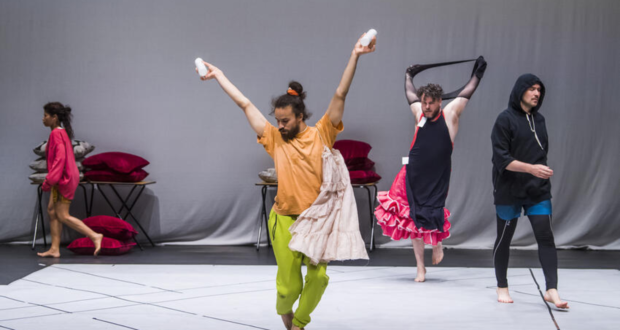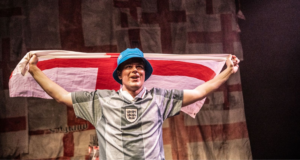An ‘Emperor’s New Clothes’ experience where an interesting premise is in reality a confusing and rather self-indulgent delivery.Summary
Rating
Ok
Porca Miseria – Triple Bill sees internationally renowned choreographer Trajal Harrell bring a trio of dance works to The Barbican. The pieces celebrate three strong women – Maggie from Tennessee Williams’ Cat on a Hot Tin Roof, the African-American choreographer and activist Katherine Dunham, and Medea from Greek mythology. That’s how they link up, which is an interesting and indeed admirable premise. However, the phrase Porca Miseria translates from the Italian to an approximation of “For goodness sake!”, and sadly that’s very much the sentiment I left with following this four hour long production. Although there were certainly elements within it to like, the experience felt largely like watching The Emperor’s New Clothes: whilst others seemed to revel in the performances, I found the event incohesive and verging on the self-indulgent in places.
The evening begins with the dance piece Deathbed on the main stage, the audience seated around on cushions. The diverse and enthusiastic cast explore gender in their costuming and movement, and I’m initially excited to see the poised strutting of the dancers, as they slink on tiptoes, bringing the runway to the theatre stage. Against an eclectic soundtrack, they carry themselves with pace and control to embody ideas of strength, liberty and civil rights. There are interesting styling choices, with multiple cultures represented in the constantly fluxing costume changes. I’m keen to see where this, the voguing, ballroom style and fragmented staging would come together. But they never really do, remaining as disjointed references that fail to coalesce into an actual message or understanding. Perhaps it’s enough that an uncommon style of performance is represented on a trophy stage like the Barbican, but I sensed a missed opportunity to make the work truly impactful.
The cushion seating proved problematic when I wanted to view a scene with dolls that was performed on the floor, in a style reminiscent of Hawaiian hula kiʻi puppetry. I could only partially see because an actor was sitting directly in front of me obscuring sightlines.
After an hour long break we return to view a short film called O Medea. However, I really got no sense of a Greek tragedy from what I saw. What is perhaps a Greek chorus of people in a glass building writhe around being sad and floral while a pendulum swings across a model of what might have been a town. I couldn’t be sure. Some shots of the camera crew suggest transparency of the creative process, but I don’t know why. On the whole the film feels like a naive student project and is unsatisfying.
The evening rolls on into a piece entitled Maggie the Cat, which involves the cast again strutting the stage, initially clutching sofa cushions, then wrapped in towels and later in bedding, which at points was used imaginatively. There’s a definite attempt at playfulness but I really wasn’t feeling it by this stage, so it just came across as self-indulgent. The three pieces together felt ill-fitting and disparate, rather than complementary and enlightening.
London is not short of fantastic dance performances, with greats like Pina Bausch and Peeping Tom totally smashing it, and there’s a real thirst for interesting, innovative work. This bill has exciting potential and could be an opportunity to stake a mainstream space for underrepresented dance forms, but it doesn’t see it through. Throughout the evening there were missed opportunities – chances to be sculptural; to fill the enormous Barbican stage with theatrical images and shadows, being visually dynamic and impressive; to clearly articulate ideas of gender and political tensions through movement. Instead it felt repetitive and limited, self-congratulatory and very, very long.
Direction, Choreography, Costume Design & Sound Design by: Trajal Harrell
Set Design by: Erik Flatmo & Trajal Harrell
Lighting Design by: Stéfane Perraud
Sound by: Melvyn Coote
Produced by: Emma Cameron
Wardrobe by: Sally Heard
Porca Miseria runs at the Barbican until Sunday 14 May. Further information and bookings here.
 Everything Theatre Reviews, interviews and news for theatre lovers, London and beyond
Everything Theatre Reviews, interviews and news for theatre lovers, London and beyond



